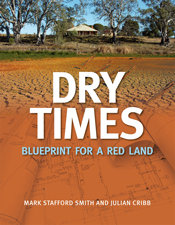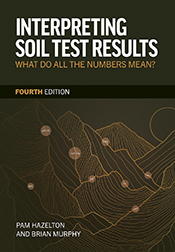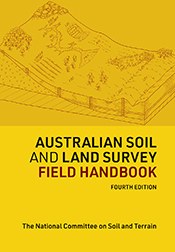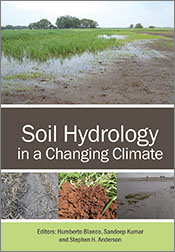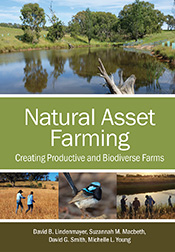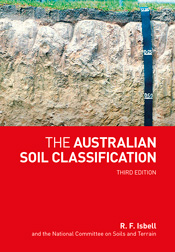Dry Times
Blueprint for a Red Land
By: Mark Stafford Smith, Julian CribbDeserts can teach us new ways to live, manage scarce resources, cope with a harsh climate, isolation and a lack of water and energy.
With knowledge from our deserts, Australians can reshape the human story. Dry Times: Blueprint for a Red Land provides new insights into how our desert environments and institutions work – and how this affects the people living in them, Aboriginal and non-Aboriginal alike. + Full description
It shows that the desert offers solutions to the challenges of living in an uncertain and threatening age, teaching us new ways to live, manage scarce resources, and cope with climatic extremes, isolation and lack of water and energy. These lessons apply not only to remote regions, but also to cities and entire nations as humanity faces growing scarcity of vital resources.
With vivid examples drawn from Australia's desert life, outback people, animals and plants, Dry Times holds many positive lessons for our nation and humanity in a changing and resource-depleted world.
- Short descriptionNews
This title is no longer available in print format, but can still be purchased as an eBook via the eRetailer links above.
Reviews
"The chapters in the book flow smoothly into each other and the writing style is clear and vibrant. The abundant boxes and diagrams are easy to understand and are used to good effect.
All in all, this book is a delight to read. More importantly, the insights provided do much to clarify how deserts operate, particularly in a socio-environmental context, how their governance can be improved, and how the lessons learnt from them can benefit the entire nation (and world) in increasingly drying and resource-depleted times."
Bea Somer, Pacific Conservation Biology, Volume 17, No 1, 2011
"It is a treat to read an ecologically based text which not only crystallises current understanding of an environment but also uses this knowledge to offer a way forward in the face of the increasing uncertainty posed by climate change. This book emanates a positive outlook to the end – the final chapter distils a set of responses for ensuring sustainable human livelihoods in the desert. I recommend this book to anyone with a broad interest in arid and semi-arid environments - scientists, graduate students, policy- or decision-makers, managers, and the public. It lives up to its name of providing a blueprint for the management and development of the enchanting arid lands of Australia. Hopefully others will consider its lessons for their corner of the world."
Timothy G O'Connor, Pastoralism: Research, Policy and Practice, 1:11 , 2011
"…an informative and well-written book. I would recommend it to anyone who wishes to gain a broad overview of the ecological and social context of the Australian arid zones, and its management."
Helen P Waudby, Ecological Management & Restoration, Vol 12 No 2, April 2011
"Firstly, it is not a 'dry' (sorry for the pun) academic text, but rather a confronting coverage of the role and importance of desert regions and communities, and their resilience."
Neil Tindale, Australasian Journal of Environmental Management, Vol 17, September 2010
"…simply expressed message of this book is that we can learn lessons from the highly evolved strategies of the inhabitants of the deserts, including the humans, that will help Australians to appreciate and to utilise efficiently their lean red land."
Peter Moore, Bulletin of the British Ecological Society 2010, Vol 41:3
"…a highly engaging volume which readily conveys complex dryland science in a tangible manner. Overall, Dry Times is an insightful and timely book which is highly relevant to planning and adapting to water stress, desertification and related effects of climate change. Though the book is mostly focussed on Australian deserts, the lessons of the book draw on a well established global science program and relate to a broader international context."
Thomas G Measham, Landscape and Urban Planning, 2010
"…a provocative primer on desert life, with an emphasis on innovations and adaptations not only to the extreme variability and aridity of desert environments, but also to the remoteness from centres of population, power and governance."
Maria E Fernandez-Gimenez, African Journal of Range & Forage Science, 27(2) 2010
Details
ePDF | December 2009ISBN: 9780643098039
Publisher: CSIRO Publishing
Available from eRetailers
ePUB | December 2009
ISBN: 9780643101814
Publisher: CSIRO Publishing
Available from eRetailers
Contents
AcknowledgementsPrologue
Dramatic deserts
Spreading deserts: past and future
What drives deserts?
Desert survivors
Living off a lean landscape
Dry but smart: tomorrow’s desert business
Surprising settlements
Tantalising technologies
Desert democrats
Deserts and our future
Epilogue
References
Endnotes
Index
Authors
Mark Stafford Smith is a desert ecologist and systems thinker, who has lived in Alice Springs and worked on desert research for the past 25 years, now resident in Canberra. He is the author of over 150 peer-reviewed publications on the ecology and management of outback Australia. He won the NT Research and Innovation Award in 2005 for his contribution to desert knowledge, and sits on several national and international advisory groups related to climate change and desertification.Julian Cribb is a science communicator and writer and a Fellow of the Australian Academy of Technological Sciences and Engineering. He is a former newspaper editor and director of National Awareness for CSIRO. He holds 32 awards for journalism.

